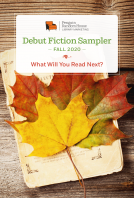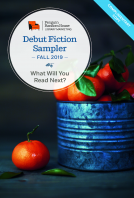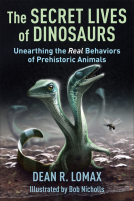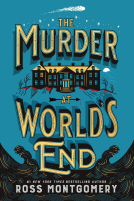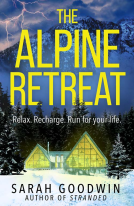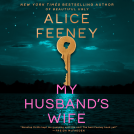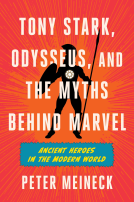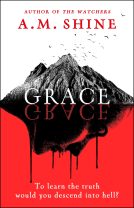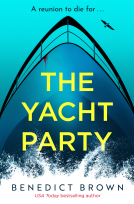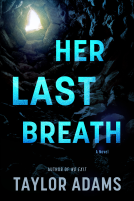
The Book of Horror
The Anatomy of Fear in Film
by Matt Glasby
This title was previously available on NetGalley and is now archived.
Send NetGalley books directly to your Kindle or Kindle app
1
To read on a Kindle or Kindle app, please add kindle@netgalley.com as an approved email address to receive files in your Amazon account. Click here for step-by-step instructions.
2
Also find your Kindle email address within your Amazon account, and enter it here.
Pub Date Sep 22 2020 | Archive Date Sep 22 2020
Quarto Publishing Group – White Lion | Frances Lincoln
Talking about this book? Use #TheBookofHorror #NetGalley. More hashtag tips!
Description
'... the definitive guide to what properly messes us up.' ― SFX Magazine
'Glasby anatomises horror's scare tactics with keen, lucid clarity across 34 carefully selected main films – classic and pleasingly obscure. 4 Stars.' ― Total Film
The Book of Horror introduces you to the scariest movies ever made and examines what makes them so frightening.
Horror movies have never been more critically or commercially successful, but there’s only one metric that matters: are they scary? Back in the silent era, viewers thrilled at Frankenstein and Dracula. Today, the monsters may have changed, but the instinct remains the same: to seek out the unspeakable, ride the adrenaline rush and play out our fears in the safety of the cinema.
The Book of Horror focuses on the most frightening films of the post-war era – from Psycho (1960) to It Chapter Two (2019) – examining exactly how they scare us across a series of key categories. Each chapter explores a seminal horror film in depth, charting its scariest moments with infographics and identifying the related works you need to see.
Including references to more than 100 classic and contemporary horror films from around the globe, and striking illustrations from Barney Bodoano, this is a rich and compelling guide to the scariest films ever made.
The films:
Psycho (1960), The Innocents (1961), The Haunting (1963), Don’t Look Now (1973), The Exorcist (1973), The Texas Chain Saw Massacre (1974), Who Can Kill a Child? (1976), Suspiria (1977), Halloween (1978), The Shining (1980), The Entity (1982), Angst (1983), Henry: Portrait of a Serial Killer (1990), Ring (1998), The Blair Witch Project (1999), The Others (2001), The Eye (2002), Ju-On: The Grudge (2002), Shutter (2004), The Descent (2005), Wolf Creek (2005), The Orphanage (2007), [Rec] (2007), The Strangers (2008), Lake Mungo (2008), Martyrs (2008), The Innkeepers (2011), Banshee Chapter (2013), Oculus (2013), The Babadook (2014), It Follows (2015), Terrified (2017), Hereditary (2018), It Chapter Two (2019)
Available Editions
| EDITION | Other Format |
| ISBN | 9780711251786 |
| PRICE | $30.00 (USD) |
| PAGES | 176 |
Average rating from 31 members
Featured Reviews
 Danielle L, Reviewer
Danielle L, Reviewer
Thank you to the publisher and Netgalley for the opportunity to read and review this book. Unfortunately and disappointingly, I do not have the capabilities to read it in the protected pdf format. Thank you.
 Jo A, Reviewer
Jo A, Reviewer
The Book of Horror by Matt Glasby is a perfect book for all horror fans who would like to know more about their favourite classic horror films. Informative and interesting.
I'm a huge horror fan and I loved this book! It really goes into depth on the tactics used to create a scary environment.
I definitely recommend this one if you like horror.
Thank you to the publisher for providing me with a copy of this E-book to review via Netgalley.
 bel R, Reviewer
bel R, Reviewer
DING DONG DARLING thank you so much NetGalley for providing a copy of this book in exchange of a honest review.
OMG this book is a MUST READ for every horror lover. It’s amazing; the way it picks (with a good, solid system) a carefully chosen selection of horror movies and explains simply but with great knowledge WHY they’re scary.
I LOVED the selection. I’m extremely happy for that I have seen almost all of them, and obviously I wrote down the few I haven’t watched. Extra kudos for adding some ‘international’ movies there. Everyone should watch The orphanage.
The edition is FLAWLESS, MARVELOUS, BEAUTIFUL and I want to buy this book and display it, opened, on a top shelf. I would have chosen a different cover, tho.
Congrats to the author! Amazing book.
The Book of Horror is an amazing dissection of what makes horror movies scary.
The book starts off with a more general information on suspense in movies and later looks at iconic horror movies in detail, examining how different things contribute to the movie being horrifying and dreadful.
It was a curious read, although I wasn't as interested in reading about movies that I haven't seen yet. The descriptions of the scenes from the movies, while quite good, are much better if you've seen the movie already and know exactly how the scene played out.
I definitely recommend the book to any movie and horror lovers.
*Thanks to NetGalley and Quarto Publishing Group – White Lion for providing me with an ARC of this title in exchange for an honest review.*
**I received and voluntarily read an e-ARC from NetGalley in exchange for an honest review. All thoughts and opinions are my own.**
I love breaking down and studying films, so I jumped at the opportunity to read and review this book.
Obviously, it doesn't contain every horror movie ever made, but the ones it lists are each studied in detail. The intro opens up with what makes a good horror movie work and why some movies that are classified as horror aren't truly horror films.
The book balances nicely between almost academic level discussions on what works and what doesn't, but it also manages to be approachable and you can sense the author's love of horror films in every sentence.
This book would be a great one to give to any horror movie fan or filmmaker you know.
If you love horror it's a must! It is very well written and beautifully put together, illustrations are amazing! It takes every film apart minute by minute, scene by scene and explains the science of horror, a very curious read! I didn't see all of them films myself, but still did enjoy it a lot, if you're a horror lover you're in for a treat!
This book is a treat for horror fans. I’ve seen most of the movies discussed here and the author’s analysis was eye-opening. The Shining is one of my favorite films, I’ve lost count of how many times I’ve seen it and Matt Glasby made me notice new things. As per its subtitle, The Anatomy of Fear in Film, there are all kinds of horror movies here: Ghost stories, slasher flicks, supernatural villains and serial killers; commercial and not widely known; foreign and domestic. The illustrations are gorgeous and the charts that track the tension throughout the films are fun to check out. The author also uses a system to code the ways that the tension is achieved. Even the films that I haven’t seen captured my interest and made me want to stream them asap. The Book of Horror is an innovative way to look at scary movies.
I chose to read this book and all opinions in this review are my own and completely unbiased. Thank you, NetGalley/White Lion Publishing!
I LOVE classic horror movies, so when I saw this I knew I had to read it! This book was so fun and chockful of information! Very informative, well written and covers EVERYTHING! I am definitely going to get a hard copy for myself, and it will make a great gift for a few people I know!
Good review and analysis, with ratings, of many popular horror films! Pictures included and recommendations for fans of each film.
 Dannielle F, Reviewer
Dannielle F, Reviewer
An excellent breakdown of what makes horror films so horrifying. It included a lot of films I've seen, and quite a few that I haven't but that I am now intending to look up! I appreciated the way the information was broken down and presented.
The Book of Horror: The Anatomy of Fear in Film by Matt Glasby
Thank you to NetGalley for providing a free copy in exchange for an honest review.
Overall, this book is a lovely celebration of a creepy and macabre genre that is so often misunderstood. It gives fun facts you might not necessarily have known - I didn't know that Jamie Lee Curtis is the daughter of Janet Leigh, who famously got murdered in the shower in Psycho. Or that The Others may have been set in Jersey, but it was written and directed by a Spanish-Serbian man and filmed in Australia.
I love the use of the symbols denoting the 7 main Scare Tactics used throughout horror and how the book uses them to analyse each film. At times the plot graph scare-o-meter seems a little pointless and just put in to fill up the page space, but it is fun to look at where is considered the scariest moment of each film.
Every chapter is accompanied by an illustration from Barney Bodoano, some of which are downright unsettling. It might have been interesting to see some colour illustrations, perhaps some old film advertisements or something similar, but the illustrations that were there were perfectly spooky.
This book would be a good gift for somebody who likes mainstream horror, but anyone who loves obscure indie films and is a bit of a horror snob might not like the fact that the main films discussed are predominantly the most obvious examples in the genre. (but perfect for someone like me!)
The recommendations that accompany each chapter are often interesting and very relevant. They gave me tons of recommendations for friends – even some for my super hipster boyfriend (despite him only liking very obscure horror and claiming all films that I find actually scary [The Babadook, Sinister, Annabelle Creation] as 'just comedies really' and 'not scary at all')
Most of the films are available on streaming services, either free or to buy, however there are a few major exceptions: The Innocents, Who Can Kill A Child, The Entity, Angst, Henry: Portrait of a Serial Killer, The Eye, The Orphanage and Lake Mungo. A couple of the recommendations are also unable to be sourced digitally, including some I personally was really interested in, such as: The Poughkeepsie Tapes, Switchblade Romance and Saint Maud among others. This wouldn't be that much of a big deal, apart from the fact that in the prologue, it is stated that one of the categories for a film being included in this book was that it had to be 'legally and readily available'. I would argue, that, in this day and age, 'readily available' translates into being on Netflix or Amazon, and perhaps a horror-specific streaming service such as Shudder at a push. However, this is by no means a bad thing, other than for my wallet when I buy all the DVDs! However, I really like that it includes films that were only out this year, such as The Lighthouse, which only came out on DVD about a week or so ago.
Some films get more space, which always seems to work better. The Descent is one of the films to get 4 pages instead of 2 and the analysis is more in depth, and more interesting as a result.
This would be a wonderful coffee table book and/or handbook for either horror enthusiasts or budding novices.
Subtitle: The Anatomy of Fear in Film
I received a complimentary copy of this book through Net Galley in exchange for an honest review.
The Book of Horror examines a sampling of post WWII horror films to determine the various techniques the filmmakers used to create horror. It includes a mix of undisputed classics and more recent and probably lesser known films. Along with each main film featured, it includes brief descriptions of three other films that explore similar horror themes.
At the beginning, the book defines seven distinct methods of horrifying audiences. I'll list a brief summary below:
Dead space - This is the amount of background included in each frame. Either too much or too little can be unsettling, as well as offering opportunities for showing details in the background to startle or create dread or doubt in the viewers mind.
Subliminal - The use of subtle visual or audio clues that may go unnoticed.
The Unexpected - Jump scares or plot twists
The Grotesque - Blood and gore
Dread - Creating apprehension that something horrible is going to happen
The Uncanny - Creating the feeling that something is just not 'right'
The Unstoppable - Creating a sense that the horror is never going to end
The part of this book I liked the best were its breakdowns of classic horror films that I've already seen, such as Psycho, The Haunting, The Exorcist, Texas Chainsaw Massacre, Halloween, The Shining, Blair Witch Project, and IT, Chapter 2. In addition for the analysis previously mentioned, there were also comments from the directors and bits of trivia that provided additional depth to my knowledge of those films. For movies I hadn't seen, such as The Ring, it provided a long-form synopsis that gave me an image of what happened in the film and why. Probably 50-60 percent of the films mentioned were ones I had never heard of.
I gave The Book of Horror four stars. Because I'm not a fan of Japanese style horror and don't watch many foreign films, I won't be watching a lot of the recent movies covered here. The PDF version I read employed a lot of white font on black background sections, which caused some eye strain when reading on my devices. This probably isn't an issue if you read a physical copy of the book, but could cause some problems if reading a digital version.
 Linde B, Reviewer
Linde B, Reviewer
I liked this book. I was introduced to a lot of movies that I've never heard of. It had a good combination of popular movies and lesser-known ones. It gave you a lot of information, and it was really acceptable as well. I enjoyed the graphs that were presented, as well as the recommendations he gave. I will definitely go on a horror movie watching spree after this.
 The Shakti Witch R, Reviewer
The Shakti Witch R, Reviewer
Matt Glasby explores over 40 postwar horror films considered the most scary. In it each film is analysed but seven scare tactics. These are also plotted against the film timeline shown in a graph. Also shared is further viewing lists pertaining to each film.
This is a must for all serious horror movie fans and film students alike.
*eArc provided by the publisher and NetGalley
The Book of Horror by Matt Glasby is one of the newest book on the famous film genre that aims at introducing the reader with some of the most famous and worthy entries this genre has to offer to its viewers. Though there are literally hundreds of other books that have the same premise, some of which discuss many of the same movies as this one, The Book of Horror has a few tricks up its sleeve that manage to differentiate it from the rest.
- The first is the fact that it separates, names, and defines the scare tactics this genre has created and used in its history. According to Glasby, these tactics are Dead Space (the use of space as a means to create dread and anticipation), The Submilinal (difficult to notice visual and aural information that makes the viewer feel scared or uncomfortable), The Unexpected (famous and kind of cliched jump scares), The Grotesque (uncomfortable to watch visual effects, most often associated with the body), Dread (the feeling of anticipation for something scary to happen), The Uncanny (the feeling that there is something kind of wrong with what's happening on the screen), and The Unstoppable (the feeling that there is no way in which the antagonist can be stopped). As we can see, this separation of the different aspects of the horror are created to be able to include both corporeal horror in the form of killings, bodily mutations, etc. but also the psychological one. Moreover, they are applicable to all sub-genres of horror, from the formulaic teen slasher and found footage film to the headier and artsier offerings of the genre.
Each of these seven aspects of a horror film are noted in each entry in the book in at least two places. The first is within the text itself, the majority of which is dedicated to a lengthy summary of the film in question, in the form of small visualization signs representing one of the aspects. The second is through a kind of a bar chart that measures each of these aspects and gives it a mark.
The measurements bring us to the second unique feature of he book, its Scare Rating. Presented like a chart with dips and spikes, it is created as a means for the book to show the scariest parts of a film, show exactly where they happen within the film and measure them on a scale from 1 to 10. It looks cool, for sure, with the spikes looking a bit like the frantic pulse of the possible viewer of the films. Yet, it also kind of beats the purpose of the book because it works as a major spoiler for each of the films not only by saying what the scary parts are but exactly when they happen. On the other hand, the book doesn't really say anything new that might be of interest for a longtime fans of the genre... This quality slightly hurts the quality writing by Glasby and incredibly beautiful illustrations by Barney Bodano which manage both to represent the movie in questions but also to show it in a somewhat unique style. Despite these minor flaws, the book is a worthy possession for most cinema fans, especially the ones interested in horror.
Readers who liked this book also liked:
Dean R. Lomax; Robert Nicholls
Nonfiction (Adult), Outdoors & Nature, Science
Ross Montgomery
General Fiction (Adult), Historical Fiction, Mystery & Thrillers
Peter Meineck
Arts & Photography, History, Nonfiction (Adult)
